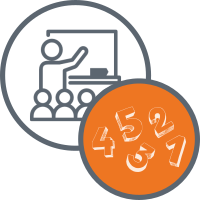You are here
Equity-Based Mathematics Teaching Practice 5: Drawing on Multiple Resources of Knowledge
Instructional Support Menu
Drawing on Multiple Resources of Knowledge
Mathematics learning and performance can be highly dependent on context and a substantial body of research has provided examples of students and adults who exhibit mathematical thinking in reasoning in their everyday lives yet struggle when given the same mathematics outside of that context, like in a mathematics classroom. These findings reveal to us how important it is to not only connect students’ experiences to classroom learning, but to value students’ experiences and spaces as legitimate resources for mathematical study and understanding.
The Practice in Action
Aguirre, Mayfield-Ingram, and Martin (2013, pp. 43-48) summarize the practice of drawing on multiple resources of knowledge by describing what it does and doesn't look like in a lesson, considerations for assessment, and questions for teacher reflection.
Caution! Don't over-estimate your own understanding based on these brief descriptions of teaching practice. Professional educators should dig more deeply into related resources, join study groups and professional networks, and seek out professional development and coaching to ensure high-quality engagement in the practice.
A representative lesson
- Makes intentional connections to multiple knowledge resources to support mathematics learning.
- Uses previous mathematics knowledge as a bridge to promote new mathematics understanding.
- Taps mathematics knowledge and experiences related to students’ culture, community, family, and history as resources.
- Recognizes and strengthens multiple language forms, including connections between math language and everyday language.
- Affirms and supports multilingualism.
A non-representative lesson
- Treats previous math knowledge as irrelevant or problematic (assuming, for example, “They lack skills,” or “They don’t know any math”).
- Builds on negative stereotypes of the culture, community, or family, preventing math lessons that connect with authentic knowledge and experiences of students. (Such negative stereotypes include notions like, “Many parents are laborers--they can’t help their children with math,” “Asian families support mathematics--that’s why Asian students are so good and so quiet,” and “That is not how we do division in the United States.”)
- Discourages mathematics discourse because it is deemed too difficult for students who have not mastered standard English.
- Supports English as the only language spoken in the classroom.
Assessment considerations
- A task involves the creation of stories of situations to solve or represent the problem
- Communication offers connections to mathematical ideas that students may know but did not use in their solution or explanation.
Questions for reflection
- How do I make connections with students’ previous math knowledge?
- How do I get to know my students’ backgrounds and experiences to support math learning in my classroom?
- How do I affirm some of my students’ multilingual abilities to help them learn math?
- What impact have race and racism had on my mathematics lessons?
- How can I learn from family and community members to support my students’ mathematical confidence and learning?
- How can I effectively communicate with families the strengths and needs of students to affirm their math identities and promote math learning?
Resources
- The Impact of Identity in K-8 Mathematics: Rethinking Equity-Based Practices by Aguirre, Mayfield-Ingram, & Martin (2013)




Connect With Us




